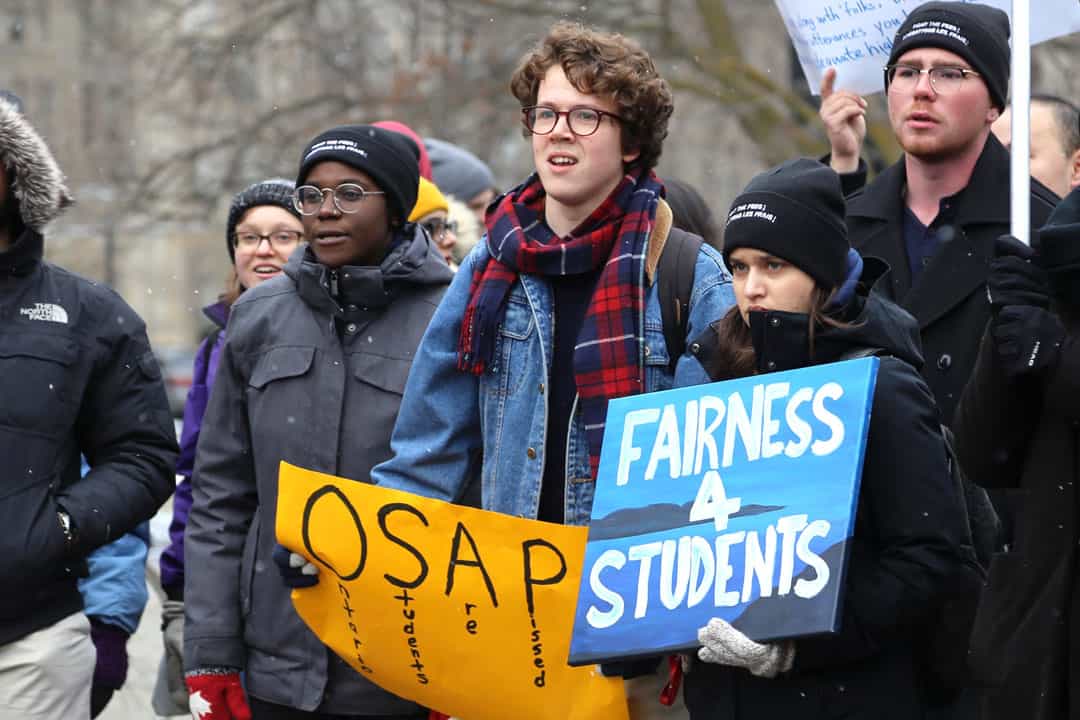The provincial government’s recently announced changes to the Ontario Student Assistance Program (OSAP) have been met with protests and widespread criticism, and for good reason — how can the government enact such a consequential move when it has insufficient data, all the while cowering behind the guise of program sustainability and student affordability? To try and make sense of the Progressive Conservatives’ (PC’s) move, let’s put into context the previous Liberal government’s program changes and delve deeper into the government’s principal evidence trove: last month’s Auditor General report.
While proposing the 2016 budget, the Liberals announced a plan to completely redesign student financial assistance, based on several reports such as the 2012 Drummond Commission report, with the goal of increasing accessibility and affordability. The principle change would be the provision of a majority of the funds upfront — in the form of grants — while eliminating loan forgiveness programs and tuition tax credits to counterbalance the rise in costs. Other changes included consolidating existing OSAP grants, modifying eligibility criteria to recognize family size as well as income, and expanding support for mature students. This sweeping transformation resulted in the program cost jumping from $1.347 billion in the 2016–2017 academic year to $1.614 billion in 2017–2018 — an almost 20 per cent increase that surpassed previous projected estimates — but should it have led to the PC’s latest program repeal?
The sudden increase is not only due to the change in the composition of student aid but also thanks to an increase of 24 per cent in the number of university OSAP recipients and 27 per cent in college recipients. The surge in uptake rates is what the redesign was supposed to do — make more students eligible for a reduction in loans.
The Auditor General Bonnie Lysyk sees this same statistic as a sign that money is going to those who don’t need it, with no proof of aid being received by the low-income communities. Moreover, she argues that by the 2020–2021 academic year, the program cost would have ballooned to $2.012 billion — a 50 per cent net increase from 2016–2017.
How exactly did the Auditor General arrive at this projection in the first place?
OSAP costs would have to increase at a pace of more than 7.6 per cent year-on-year from 2017–2018 to reach the purported $2.012 billion target. This is more than twice the annual increase from 2013–2014 to 2016–2017 when the average annual increase was 2.09 per cent. How can the Auditor General justify such a projection, based on only one year’s worth of evidence? Especially considering the PC’s own argument that the increase in enrollment has been modest at a rate of one to two per cent? In fact, as the program takes effect and the dust settles, the ministry will tighten oversight and we could expect a plateau in costs.
How do the PC’s want to proceed instead? Their answer is with a 10 per cent tuition cut across the board, a freeze for the 2020–2021 academic year, and the possible opt-out option non-tuition fees. This “historic” proposal will not do much to help those who need financial support for education the most. The Minister of Training, Colleges and Universities Merrilee Fullerton said it herself: on average, the program will save a university student $660 per semester — hardly enough to cover textbooks for most programs.
The government will also not be providing any support for the institutions to recoup their losses, saying that a 10 per cent cut will only amount to a two to four per cent reduction in operating revenues. But even so, two years of consecutive declines could lead to universities hiking tuition at a hitherto unseen rate from 2021–2022 onward if the government does not implement any restrictions. In the interim, to make up for lost domestic revenues, the universities could also increase international enrollment and tuition for which there are no provincial regulations. The other thing to note is that the PC’s have not clarified whether they will be reinstituting the loan forgiveness grants and the tuition tax credits that the Liberals scrapped in favour of the comprehensive grant program.
Empirically and from a policy standpoint, many studies show that a tuition decrease does little to improve affordability and accessibility, but instead lowers the quality of education. On the other hand, other studies have shown that increasing the proportion of non-repayable funds will have a positive effect on enrolment — given time — and enhance accessibility for those families in the lower income brackets.
In the short run, the PC’s will reduce OSAP costs and achieve a more balanced budget. However, wouldn’t taking on a short-term deficit to improve the quality of education instead be a risk worth taking? At minimum, they could have increased the proportion of loans for middle-income families while instituting tighter controls on the disbursement of grants.
In reality, the disbandment of the Liberal policy is just a political manoeuvre. At the end of the day, the students will pay the price.


